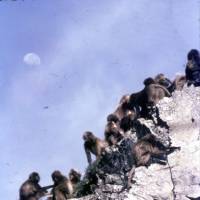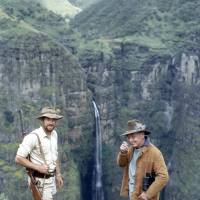By the time you read this I should be in the Simien Mountains of northern Ethiopia. I have been asked to go back there to tell the nation's current generation what the forests and wildlife were like in 1967, '68 and '69 when I served the government of Haille Selassie as the country's first game warden and set up the Simien Mountains National Park.
Back then, things were pretty basic. There was no road into the Simien, and everything except chickens, eggs, goats, sheep, very small potatoes, garlic, chilli peppers, barley, wheat, millet and teff (a grain used to make the national dish of injera pancakes) had to be bought in to the primitive trailhead of Debarek. From there it was hauled in by horse, mule or donkey. Long timbers were carried in by teams of men.
I lived in a tent for the first year, and even when I finally got my house built, there was no electricity and we fetched water from a spring. The outside toilet was clean, but simple; a wooden seat with a hole in it and a bucket with some water and creosote underneath. After each bog bucket was dumped, we'd scatter woodash over its contents to control the flies and smell.
My base camp and house were more than 3,000 meters above sea level, so it got very cold at night. We had a fire and a wood-burning stove, but we used only dead wood because living trees could not be cut in the park area. That meant our firewood was brought in by pack animals. At night I'd often share drinks and tales with my assistant, Mesfin, or with visitors who made the effort to venture out so far. Beside a warming fire, with lamps and candles, we'd maybe have a song or two — and the luxury of being able to play with a big German shepherd dog who'd sprawl on a locally woven woollen rug at my feet.
I never missed television, of course, and when it got dark if I ever wanted to gaze at something truly magnificent, I'd go outside and look at the stars. I did, however, have a small transistor radio that I tuned to the BBC. It was thanks to that, on July 20, 1969 (three days after my 29th birthday), that I heard about the success of the Apollo 11 lunar expedition — and that Neil Armstrong and Buzz Aldrin had walked on the Moon and taken pictures of the Earth.
I told Mesfin and he was incredulous, and when I told some of the rangers they thought I was inventing another story like the ones I loved to tell. That day, though, the Moon was clear to see during the day from the Simien, and I took a photograph of a group of Gelada baboons looking intently at it. Maybe they had also heard the news — but because they have such good eyesight, perhaps they'd just seen some movement up there.
I had a small telescope that I used to spot Walia ibex on the cliffs, and at times I would bring it out at night. I'd focus on the Moon and show it to the rangers or to local mountain men who often bivouacked overnight at our base camp because it was relatively safe from hyenas and bandits. When I told those folk there were mountains on the Moon — and that all the rings they could see on its surface were made by huge rocks from outer space hitting it — they laughed with delight.
"Why don't big rocks hit our Earth?" one tribesman asked.
"Sometimes they do," said ranger Mitiku, "and it says so in the Bible. We see streaks of fire in the night sky, right? Well that's the sword of the Archangel Gabriel, smiting the boulders that the Devil hurled at us."
When I was a boy, my favorite place to stay during the holidays was with my Auntie Peg. She was a tiny little Welsh lady with a huge sense of humor and a shrieking, cackling laugh that set off everybody around her. She and her family lived in a little stone cottage a 5-km walk from the main road into the town of Neath where my home was.
The cottage had no electricity, gas or running water. Dogs, chickens and the occasional orphaned lamb would come into the back kitchen. The cats of course went wherever they wanted to. At night we could see the blinking of the Mumbles lighthouse about 30 km away. I remember that cottage being a wonderland of stories told at night around the fireplace with oil lamps casting their gentle light and a candle in a holder to lead the way to bed.
The other week, we had a meal for our Afan Woodland Trust staff and researchers at the new center we've built outside Kurohime in the Nagano Prefecture hills. After the feast, which included wild boar stew, I lit candles, turned off the lights and put some big logs on the fire in the brick-and-stone hearth of the main hall.
We brought chairs to make a semicircle around the brightly blazing fire, where we sat and relaxed, had a few drinks and chatted. It was gone 11 p.m. when we called it a day, though no one had noticed the time going by.
As we enter the Year of the Horse, and all of us in Japan surely have thoughts about nuclear and other forms of energy in the back of our minds, I have become ever more certain that the simple life really does give me by far the most comfort and pleasure. After all, it carries with it none of the guilt of having used a hideously dangerous form of power that will go on polluting and endangering all life on Earth for tens of thousands of years.
Meanwhile, as a festive treat a friend sent me two large boxes of fresh wild oysters. We couldn't possible eat them all raw, so I steamed them and, as the shells opened, salt water and their bodily fluids merged into the boiling water. After extracting the oysters from their shells, I filtered off the liquid and boiled it some more to concentrate it before pouring it over the oysters and putting the lot in an earthenware pot that I sealed with a tight cork lid. Stored in the back pantry which remains just above freezing all winter, we'll now have oyster snacks for the next three months.
While writing this article, I've gazed outside from time to time at the fresh snow piled on all the branches and twigs, with my neighbor's white-capped barn the only other building visible in one direction and the Torii River and Mount Kurohime in the other. Now, the light is fading and soon it will be time to snack on a few of those oysters, a cat on my lap, while sipping snow-chilled white wine.
Life is good, and I hope that next time I write this column I will be able to relate to you tales from under those Simien stars in Ethiopia — the same stars that twinkled back when Man walked for the first time on the Moon as Gelada baboons looked on.




